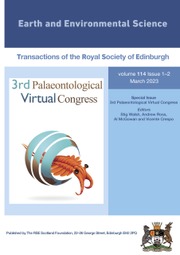Crossref Citations
This article has been cited by the following publications. This list is generated based on data provided by
Crossref.
Cabreira, Sergio F.
Schultz, Cesar L.
Bittencourt, Jonathas S.
Soares, Marina B.
Fortier, Daniel C.
Silva, Lúcio R.
and
Langer, Max C.
2011.
New stem-sauropodomorph (Dinosauria, Saurischia) from the Triassic of Brazil.
Naturwissenschaften,
Vol. 98,
Issue. 12,
p.
1035.
Irmis, Randall B.
Mundil, Roland
Martz, Jeffrey W.
and
Parker, William G.
2011.
High-resolution U–Pb ages from the Upper Triassic Chinle Formation (New Mexico, USA) support a diachronous rise of dinosaurs.
Earth and Planetary Science Letters,
Vol. 309,
Issue. 3-4,
p.
258.
Kubo, Tai
and
Kubo, Mugino O.
2012.
Associated evolution of bipedality and cursoriality among Triassic archosaurs: a phylogenetically controlled evaluation.
Paleobiology,
Vol. 38,
Issue. 3,
p.
474.
Racki, Grzegorz
2012.
The Alvarez Impact Theory of Mass Extinction; Limits to its Applicability and the “Great Expectations Syndrome”.
Acta Palaeontologica Polonica,
Vol. 57,
Issue. 4,
p.
681.
Padian, Kevin
2012.
The problem of dinosaur origins: integrating three approaches to the rise of Dinosauria.
Earth and Environmental Science Transactions of the Royal Society of Edinburgh,
Vol. 103,
Issue. 3-4,
p.
423.
2012.
Dinosaur Paleobiology.
p.
262.
Sookias, Roland B.
Butler, Richard J.
and
Benson, Roger B. J.
2012.
Rise of dinosaurs reveals major body-size transitions are driven by passive processes of trait evolution.
Proceedings of the Royal Society B: Biological Sciences,
Vol. 279,
Issue. 1736,
p.
2180.
Toljagić, Olja
and
Butler, Richard J.
2013.
Triassic–Jurassic mass extinction as trigger for the Mesozoic radiation of crocodylomorphs.
Biology Letters,
Vol. 9,
Issue. 3,
p.
20130095.
Nesbitt, Sterling J.
Barrett, Paul M.
Werning, Sarah
Sidor, Christian A.
and
Charig, Alan J.
2013.
The oldest dinosaur? A Middle Triassic dinosauriform from Tanzania.
Biology Letters,
Vol. 9,
Issue. 1,
p.
20120949.
Langer, Max C.
Nesbitt, Sterling J.
Bittencourt, Jonathas S.
and
Irmis, Randall B.
2013.
Non-dinosaurian Dinosauromorpha.
Geological Society, London, Special Publications,
Vol. 379,
Issue. 1,
p.
157.
Langer, Max C.
and
Ferigolo, Jorge
2013.
The Late Triassic dinosauromorph
Sacisaurus agudoensis
(Caturrita Formation; Rio Grande do Sul, Brazil): anatomy and affinities
.
Geological Society, London, Special Publications,
Vol. 379,
Issue. 1,
p.
353.
Jones, Marc EH
Anderson, Cajsa
Hipsley, Christy A
Müller, Johannes
Evans, Susan E
and
Schoch, Rainer R
2013.
Integration of molecules and new fossils supports a Triassic origin for Lepidosauria (lizards, snakes, and tuatara).
BMC Evolutionary Biology,
Vol. 13,
Issue. 1,
p.
208.
Turner, Alan H.
and
Nesbitt, Sterling J.
2013.
Body size evolution during the Triassic archosauriform radiation.
Geological Society, London, Special Publications,
Vol. 379,
Issue. 1,
p.
573.
Niedźwiedzki, Grzegorz
Brusatte, Stephen L.
Sulej, Tomasz
Butler, Richard J.
and
Benson, Roger
2014.
Basal dinosauriform and theropod dinosaurs from the mid–lateNorian (LateTriassic) ofPoland: implications forTriassic dinosaur evolution and distribution.
Palaeontology,
Vol. 57,
Issue. 6,
p.
1121.
Langer, Max C.
and
Smith, Andrew
2014.
The origins of Dinosauria: much ado about nothing.
Palaeontology,
Vol. 57,
Issue. 3,
p.
469.
McPhee, Blair W.
Yates, Adam M.
Choiniere, Jonah N.
and
Abdala, Fernando
2014.
The complete anatomy and phylogenetic relationships ofAntetonitrus ingenipes(Sauropodiformes, Dinosauria): implications for the origins of Sauropoda.
Zoological Journal of the Linnean Society,
Vol. 171,
Issue. 1,
p.
151.
Müller, Rodrigo Temp
Langer, Max Cardoso
Aires, Alex Sandro Schiller
and
Dias-da-silva, Sérgio
2014.
New Dinosauriform (Ornithodira, Dinosauromorpha) Record from the Upper Triassic of Southern Brazil.
Paleontological Research,
Vol. 18,
Issue. 2,
p.
118.
Benton, Michael J.
Forth, Jonathan
and
Langer, Max C.
2014.
Models for the Rise of the Dinosaurs.
Current Biology,
Vol. 24,
Issue. 2,
p.
R87.
Iijima, Masaya
and
Kobayashi, Yoshitsugu
2014.
Convergences and Trends in the Evolution of the Archosaur Pelvis.
Paleobiology,
Vol. 40,
Issue. 4,
p.
608.
Benson, Roger B. J.
Campione, Nicolás E.
Carrano, Matthew T.
Mannion, Philip D.
Sullivan, Corwin
Upchurch, Paul
Evans, David C.
and
Morlon, Hélène
2014.
Rates of Dinosaur Body Mass Evolution Indicate 170 Million Years of Sustained Ecological Innovation on the Avian Stem Lineage.
PLoS Biology,
Vol. 12,
Issue. 5,
p.
e1001853.


